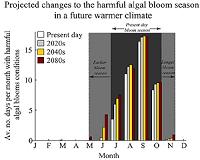| . |  |
. |
Paris, France (SPX) Feb 24, 2011 Black carbon (BC) and tropospheric ozone (O3) are harmful air pollutants that also contribute to climate change. The emission of both will continue to negatively impact both human health and climate. While our scientific understanding of how black carbon and tropospheric ozone affect climate and public health has significantly improved in recent years, the threat posed by these pollutants has catalysed a demand for knowledge and concrete action from governments, civil society, United Nations (UN) agencies and other stakeholders. The United Nations Environment Programme (UNEP) was requested to urgently provide science-based advice on actions to reduce the impact of these pollutants and the Integrated Assessment of Black Carbon and Tropospheric Ozone is the result. Its main findings are: A small number of emissions reduction measures targeting black carbon and tropospheric ozone could immediately begin to protect climate, public health, water and food security, and ecosystems. These measures target fossil fuel extraction, residential cooking and heating, diesel vehicles, waste management, agriculture and small industries. Full implementation is achievable with existing technology but would require significant and strategic investment as well as institutional arrangements. The identified measures complement, but do not replace, anticipated carbon dioxide reduction measures. Major carbon dioxide reduction strategies mainly target the energy and large industrial sectors and therefore would not necessarily result in significant reductions in emissions of the black carbon or ozone precursors; methane and carbon monoxide. Significant reductions of black carbon and O3, require a specific strategy, as emissions come from a large number of small sources. Full implementation of these measures would reduce future global warming by 0.5oC (within a likely range of 0.2-0.7oC). If the measures are implemented by 2030, this could halve the potential increase in global temperature which is projected for 2050. The rate of regional temperature increase would also be reduced. Both near-term and long-term strategies are essential. Reductions in near-term warming can be achieved by control of black carbon and O3 whereas CO2 emission reductions, beginning now, are required to limit long-term climate change. Implementing both reduction strategies is needed to improve the chances of keeping the Earth's global mean temperature increase to within UNFCCC's 2oC target. The implementation of the identified measures would have substantial benefits in the Arctic, the Himalayas, and other glaciated and snow-covered regions. These measures are all in use in different regions around the world. Much wider implementation is required to achieve the full benefits identified in this assessment. The assessment team examined policy responses, developing an outlook to 2070 illustrating the benefits of political decisions made today and the risks of delaying action for climate change, human health and crop yields over the next decades. Placing a premium on sound science and analysis, the Assessment was driven by four main policy-relevant questions: + Which black carbon and O3 control measures are likely to provide significant combined climate and air quality benefits? + How much can the implementation of the identified measures reduce the rate of global mean temperature increase by mid-century? + What are the multiple climate, health and crop-yield benefits (by region) of implementing the measures? + By what mechanisms could the measures be rapidly implemented? In order to answer these questions, the assessment team determined that new analyses were needed. The Assessment therefore relies on published literature as much as possible and on new simulations by two independent climate-chemistry-aerosol models: one developed at the NASA-Goddard Institute of Space Studies (NASA-GISS) and another developed by the Max Plank Institute in Hamburg and implemented at the European Commission's Joint Research Centre. The specific measures and emission estimates for use in developing this assessment were selected using the International Institute for Applied Systems Analysis' Greenhouse Gas and Air Pollution Interactions and Synergies (IIASA GAINS) model. The Summary of this assessment for decision makers will be presented at the 26th session of the Governing Council / Global Ministerial Environment Forum (GC/GMEF) of UNEP from 21-24 February 2011 in Nairobi, Kenya.
Share This Article With Planet Earth
Related Links European Commission Joint Research Centre Climate Science News - Modeling, Mitigation Adaptation
 Climate Projections Show Human Health Impacts Possible Within 30 Years
Climate Projections Show Human Health Impacts Possible Within 30 YearsWashington DC (SPX) Feb 23, 2011 A panel of scientists speaking at the annual meeting of the American Association for the Advancement of Science (AAAS) unveiled new research and models demonstrating how climate change could increase exposure and risk of human illness originating from ocean, coastal and Great Lakes ecosystems, with some studies projecting impacts to be felt within 30 years. "With 2010 the wettest year on r ... read more |
|
| The content herein, unless otherwise known to be public domain, are Copyright 1995-2010 - SpaceDaily. AFP and UPI Wire Stories are copyright Agence France-Presse and United Press International. ESA Portal Reports are copyright European Space Agency. All NASA sourced material is public domain. Additional copyrights may apply in whole or part to other bona fide parties. Advertising does not imply endorsement,agreement or approval of any opinions, statements or information provided by SpaceDaily on any Web page published or hosted by SpaceDaily. Privacy Statement |